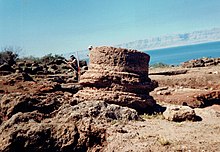Kallirhoe (bath)
Kallirhoë (today Ain az-Zara , Arabic عين الزارة) was an ancient health resort. The archaeological site is in what is now Jordan .
An 8 km long road connected the Machärus fortress with this oasis on the east bank of the Dead Sea . In ancient times, well-to-do sick people came to this secluded place with its thermal baths , villas, palms and balsam trees . Today around 40 warm springs still gush here.
Surname
The ancient name Kallirhoë, old Greek: Καλλιρρόη, "the beautiful flowing", corresponds roughly to the German "Schönbrunn". The Arabic name for the location Ain az-Zara ( Arabic عين الزارة) is derived either from zr , "sow", or - more likely - from originally al-Ain az-Zahra , "the blooming / beautiful spring", which corresponds exactly to the Greek form, with a view to the agricultural use of the oasis .
Description in ancient sources
The Jewish historian Josephus reports how King Herod , already seriously ill, placed his last hope in the springs of Kallirhoë: “That is why he tried the hot springs in Kallirhoë on the other side of the Jordan; they pour into the Dead Sea, but are sweet and edible. The doctors prescribed him full baths in warm oil, but when they tried to put him in the full tub, he collapsed exhausted and rolled his eyes ... "(Bellum I, 33,5)
Pliny the Elder mentions the health resort in his description of the eastern shore of the Dead Sea: "On the same side is the hot spring Kallirhoe with a special healing effect, which by its name indicates the fame of the water." (Hist. Nat. 5,72)
Mosaic map of Madaba
The mosaic map of Madaba (6th century AD) describes the health resort that still existed in late antiquity as "Therma Kallirhoës". You can see a circular spring, a building with an apse , a water basin with an inflow and two palm trees.
Excavations
The excavations do not reveal the details of the Madaba map. The latest stratum of the excavations dates back to the 5th century AD.
The archaeological site was investigated in three campaigns between 1985 and 1989 by a team from the German Evangelical Institute for Classical Studies of the Holy Land under the direction of August Strobel , Christa Clamer (1985, 1986) and Stefan Jakob Wimmer (1989). Structures that were interpreted as harbors were exposed directly on the bank. There were several basins about 150 m inland.
A representative building with two wings on either side of a garden (or a hall) was particularly interesting: the Herodian Villa Maritima. In the south wing there was an inner courtyard surrounded by columns, several rooms with stucco ceilings and a large basin that was fed by the thermal spring. This building was damaged during the Jewish War , but survived into the early Byzantine period.
literature
- Stefan Jakob Wimmer : Kallirrhoë: Herod's spa. In: Martin Peilstöcker, Sabine Wolfram (eds.): Life on the Dead Sea. Archeology from the Holy Land. Chemnitz / Dresden 2019, p. 9, 205–210.
- Stefan Jakob Wimmer : The Port of Machaerus: Callirrhoe - A Retrospection on the German Excavations (1985-1989) After 30 Years. IN: Gyözö Vörös: Machaerus III. The Golden Jubilee of the Archaeological Excavations. Final Report on the Herodian Citadel 1968-2018. (Studium Biblicum Franciscanum Collectio Maior 56), Jerusalem Milano Mount Nebo 2019, pp. 460–491.
- Andreas Feldtkeller : Jordan . EVA Leipzig 2007, ISBN 978-3-374-02462-9 , pp. 84-85.
- August Strobel : On the location of Kallirhoe . In: Journal of the German Palestine Association 82 (1966), pp. 149–162
- August Strobel, Christa Clamer: Excavations at ez-Zara . In: Annual of the Department of Antiquities of Jordan 30 (1986), pp. 381-384
- August Strobel, Stefan Wimmer : Kallirrhoë (ˤĒn ez-Zāra). The third excavation campaign of the German Evangelical Institute for Classical Studies of the Holy Land and excursions in South Peräa , with contributions and with the participation of Werner Böser, Roland Deines , Karlheinz Eckardt, Christoph Von Mosch, Franz Reidel and Emsaytef Suleiman (treatises of the German Palestine Association , Volume 32), Wiesbaden 2003 (summary online )
- Christa Clamer: The fortress of Machärus and the baths of Herod in Kallirhoë . IN: World and Environment of the Bible 1/1998, p. 47.
- Christa Clamer, Odile Dussart, Jodi Magness: Fouilles archéologiques de 'Aïn ez-Zâra / Callirrhoé villégiature hérodienne. Mission archéologique du German Evangelical Institute for Classical Studies of the Holy Land dirigée par August Strobel (campagnes de 1985-1986) (Bibliothèque archéologique et historique 142), Beyrouth 1997
- Werner Böser, A. Rieger: Geodetic work on the archaeological record of Herod's bath Kallirrhoë on the Dead Sea / Jordan. IN: W. Böser et al. (eds.): Geodetic, photogrammetric and cartographic reports II. (Karlsruhe Geoscientific Writings B.3), Karlsruhe, 1996, pp. 43–58.
Individual evidence
- ↑ a b Andreas Feldtkeller: Jordan . S. 84 .
- ↑ Christa Clamer: The fortress Machärus and the baths of Herod in Kallirhoe . S. 47 .
- ↑ Stefan Jakob Wimmer: Kallirrhoë: The spa of Herodes . S. 205 .
Coordinates: 31 ° 35 ′ 49.2 ″ N , 35 ° 33 ′ 33.5 ″ E


